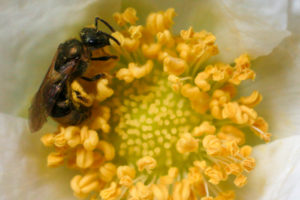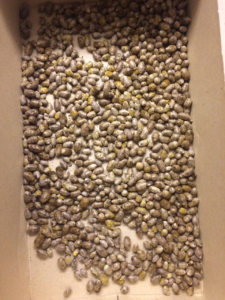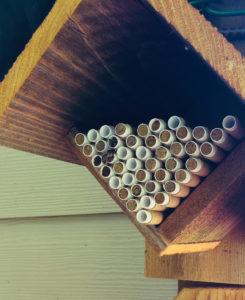Mason Bee Fun!
Sharon Hawley, OLWC Volunteer
Supporting native fauna, educating on the cycle of life, enlivening local flora, becoming comfortable with our small flying neighbors, and enjoying a daily active display of how nature works – a few of the reasons to include mason bees in your backyard habitat.

As a child and into young adulthood, I was very afraid of bees and wasps, having been badly stung early on, I was told. Eventually, as a bio major, occasional proximity lessened my fear, mostly. Much later, while planning an educational program on pollinators, I decided I should gain some firsthand experience and bring mason bees into my yard. I started in late winter by consulting with a knowledgeable friend and acquired from her 30 cocoons (about half female and half male, judging by size), 2 handmade bee houses, and 100 cardboard tubes with paper inserts. I kept the cocoons in the refrigerator. I mounted the boxes on a post on the side of my house and, around April 1, when the highs were fairly consistently above 55 degrees, I put the cocoons in a small cardboard box, with a pencil-sized hole in the side, atop the houses. I inserted the paper inserts into the cardboard tubes and layered them in the houses. It wasn’t long before the males flew out. The females followed shortly, mating happened, and the males died.
cocoons (about half female and half male, judging by size), 2 handmade bee houses, and 100 cardboard tubes with paper inserts. I kept the cocoons in the refrigerator. I mounted the boxes on a post on the side of my house and, around April 1, when the highs were fairly consistently above 55 degrees, I put the cocoons in a small cardboard box, with a pencil-sized hole in the side, atop the houses. I inserted the paper inserts into the cardboard tubes and layered them in the houses. It wasn’t long before the males flew out. The females followed shortly, mating happened, and the males died.
The females entertained our cat and I for about 2 months while they diligently filled the tubes just outside our window. An area of moist dirt nearby is a must. Each one gathered a bit of this to make a mudball, closing the far end of the tube. This was followed by a ball of pollen, mostly collected from the Oregon grape in my yard. An egg was laid on the pollen ball and a mud ball sealed that little nursery. Each bee continued to fill a tube until 8-10 eggs were laid in each one. Most activity had stopped by the beginning of June, so, leaving a few empty tubes out, I collected the filled ones.  The females die when they are done. I stood the filled tubes up in a container, with a nylon stocking pulled over the top to allow air to get in and left it in the garage. Finally, in November, I opened all the tubes, washed the 4-500 cocoons, and saved some for me in the refrigerator for the next round. I gave the rest to a cousin who has fruit trees to pollinate!
The females die when they are done. I stood the filled tubes up in a container, with a nylon stocking pulled over the top to allow air to get in and left it in the garage. Finally, in November, I opened all the tubes, washed the 4-500 cocoons, and saved some for me in the refrigerator for the next round. I gave the rest to a cousin who has fruit trees to pollinate!
The bees are natives, solitary, very gentle (I even have held one or two) and produce no honey. They are excessively successful at pollination, more so than honeybees. My Oregon grape and flowering red currant have been thriving! My cousin had a bumper crop of apples. The educational pollination program I prepared was so much better with personal knowledge, pictures, samples of cocoons and my own enthusiasm. Go native bees!
